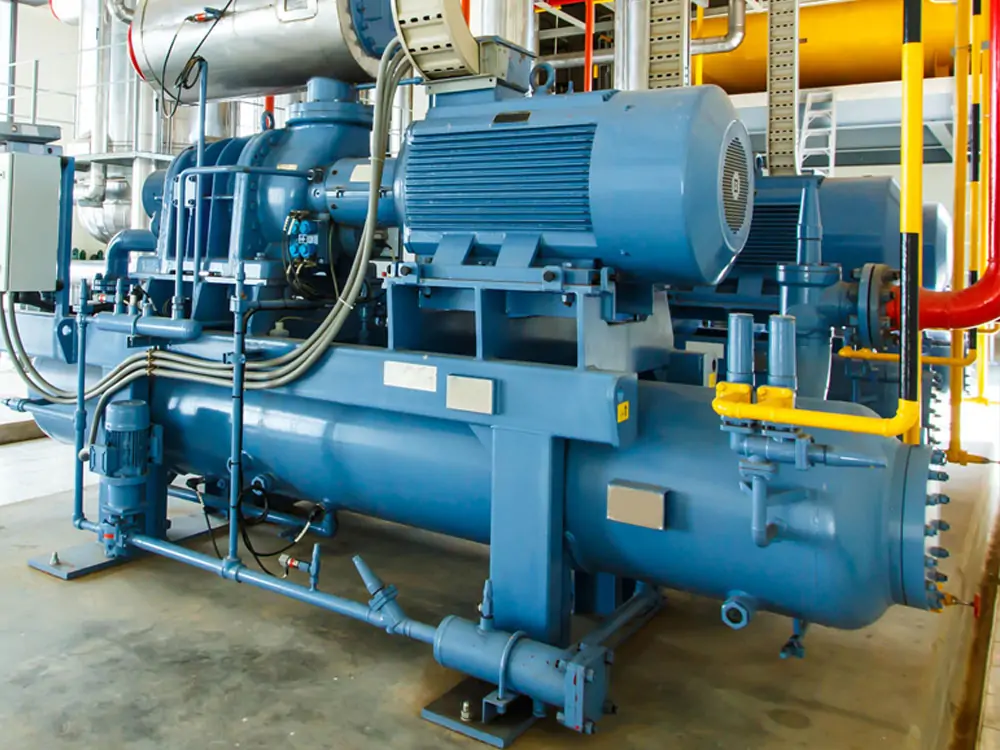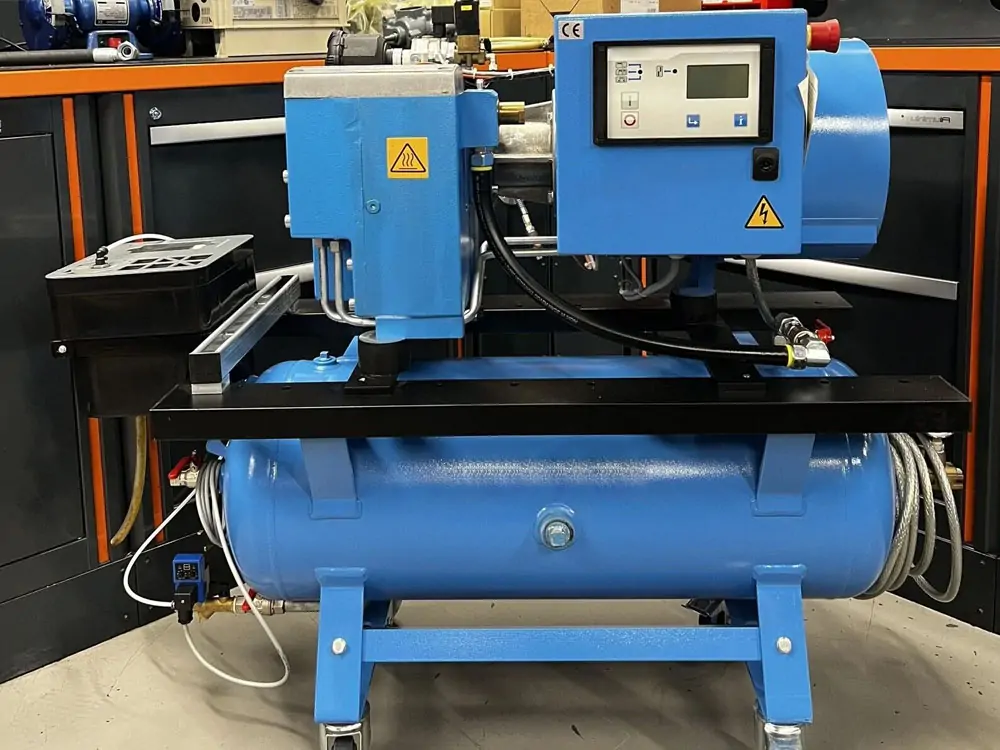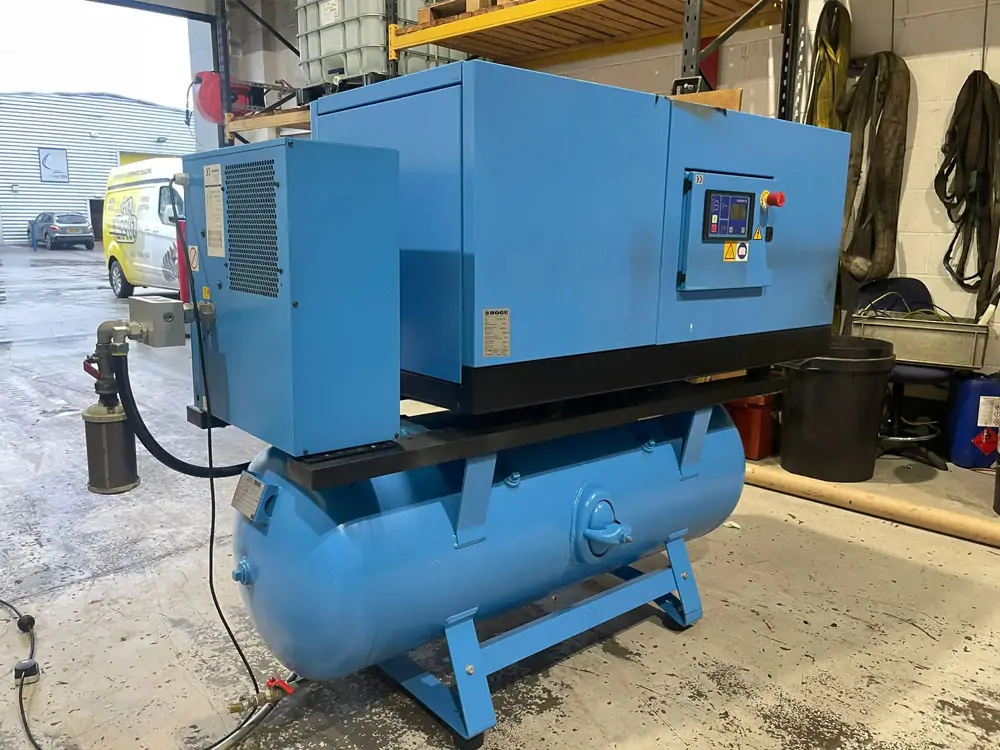In modern industry and manufacturing, air compression technology plays a crucial role. Screw air compressor is undoubtedly an important part that cannot be ignored. It has been widely used and favored for its high efficiency, reliability, and applicability to various scales. rotary screw type air compressor provides critical gas compression solutions for manufacturing, the energy industry, transportation, and many other sectors.
In this paper, we will explore the working principle of rotary screw air compressors. We will analyze its internal structure and working process in detail so that readers can have a clear understanding of the working principle of screw air compressors. Understanding how rotary screw air compressors work is crucial to understanding their high efficiency, durability, and importance in modern industry.
Rotary Screw Air Compressor Overview
The rotary screw type air compressor is a compressed air device used in the industrial and commercial sectors. It has unique working principles and characteristics. The following are its functions, classifications, and characteristics.
Function
The main function of the rotary screw type air compressor is to inhale the air in the atmosphere. The air is compressed into high pressure air by the movement of the rotating screw. High pressure air can be used in a variety of industrial applications. Such as power tools, production equipment, automation systems, cleaning processes, etc. Its main function can be summarized as.
- Provide Compressed Air: The air in the atmosphere is compressed into high-pressure air to meet the demand for high-pressure air in industrial and commercial applications.
- Improve Efficiency: Through efficient compressor components and working mechanisms, rotary screw air compressors can improve the efficiency of air compression and reduce energy consumption.
Sort
Rotary screw air compressors can be classified according to different standards. Such as classification according to the working principle, use, etc.
Classification according to working principle:
- Single stage rotary screw air compressor: only one rotary screw compresses air.
- Multi-stage rotary screw type air compressor: there are multi-stage rotating screws to compress the air successively to obtain a higher compression ratio.
Classification by use:
- Industrial rotary screw air compressors: used for compressed air requirements in industrial manufacturing, processing, and other production processes.
- Commercial use Rotary screw type air compressors: used for compressed air supply in commercial places such as office buildings, shops, restaurants, etc.
Peculiarity
- High Efficiency: The use of rotary screw technology, with a high energy efficiency ratio. It is capable of producing air with a high compression ratio at a lower energy consumption.
- Stable Operation: simple structure, smooth operation. It provides stable operation for long periods of time and reduces downtime.
- Strong Adaptability: suitable for various scale applications. It can choose different types and capacities of rotary screw air compressors according to demand.
- Low Noise: Compared with some other types of compressors, the noise of rotary screw air compressors is low. This helps to reduce noise pollution in the working environment.
- Easy Maintenance: The maintenance is relatively simple and the parts are easy to obtain. It is easy to service and repair, reducing maintenance costs and downtime.

Main Component of Rotary Screw Air Compressor
The rotary screw air compressor adopts the screw working principle. The following is the basic internal structure of the rotary screw type air compressor.
Male Rotor
The active screw is one of the core components of the screw air compressor. It is driven by an electric motor and rotates at high speed. The spiral profile of this screw draws in air, which is then compressed and delivered to the air outlet.
Female Rotor
The driven screw is located next to the active screw. It is meshed with the driving screw by gearing. Its profile is matched with the profile of the active screw so that the air can be compressed and discharged.
Compression Chamber
The compression chamber is the meshing space of the active screw and the driven screw. In this space, the air is gradually compressed. At the same time, the volume decreases and the pressure increases.
Inlet
The air inlet is used to introduce air from the atmosphere into the compression chamber for compression. This is where air is drawn in and sent to the compression chamber.
Outlet
The air inlet is used to introduce air from the atmosphere into the compression chamber for compression. This is where air is drawn in and sent to the compression chamber.
Cooling System
The cooling system is responsible for reducing the heat generated during the compression process to prevent overheating. This is usually achieved using cooling lubricants or air cooling.
Electric Motor
The electric motor provides power and drives the rotation of the active screw. It is usually connected to an active screw to achieve rotation.
Control System
The control system is used to monitor and regulate the operating state of the air compressor. Including start, stop, speed regulation, pressure adjustment, and other functions. It can ensure the safe, stable, and efficient operation of the air compressor.
How Does A Rotary Screw Air Compressor Work
The working principle of rotary screw air compressor is mainly based on the meshing movement of two spiral shapes. The whole working process is divided into three stages: suction, compression, and exhaust.
Inspiratory Phase
- Initial Stage: When the rotor screw begins to rotate, the spiral shape will gradually penetrate into the threads of the stator screw, forming a closed chamber.
- Suction: In the initial stage, the cavity is in a state of negative pressure. Air will naturally be drawn into this closed chamber.
Compression Stage
- Rotor Movement: The rotor screw continues to rotate, pushing the air towards the other end of the closed chamber.
- Compression: As the air is pushed to the other end of the closed chamber, the volume of the air is gradually reduced, and the air is compressed.
Exhaust Stage
- Exhaust: When the air reaches the set compression ratio or pressure, the exhaust valve opens and the compressed air is discharged.
- Cycle: The whole compression cycle is then restarted, and the process of suction, compression, and exhaust is continuously cycled.

Rotary Screw Air Compressor Key Parameters And Control Strategies
There are some key parameters and control strategies in the working process of rotary screw type air compressors. These ensure that the machine compresses air efficiently and stably and meets specific requirements. The following are some key parameters and control methods in the working process.
Key Parameter
- Compression Ratio: The compression ratio refers to the ratio between the compressed air pressure and the atmospheric pressure during intake. This parameter affects the performance and efficiency of the compressor.
- Discharge Temperature: Discharge temperature Indicates the temperature of compressed air. It will affect the operation safety and durability of the compressor. High temperatures can damage equipment and reduce efficiency.
- Discharge Pressure: Discharge pressure refers to the pressure of compressed air output. According to different application requirements, it is necessary to ensure that the system pressure requirements are met.
- Inlet Pressure: The inlet pressure must be kept stable within a certain range to ensure that good air enters the compressor.
- Motor Power: Motor power is the power of the motor that drives the compressor. It needs to be adapted to the operational requirements of the compressor to ensure stable compression.
Control Strategy
- Pressure Control: Pressure control is the most basic control strategy. Exhaust pressure is monitored by sensors. Adjust the motor speed or start and stop the compressor to stay within the set pressure range.
- Temperature Control: Air exhaust temperature is the key parameter. Through temperature sensor monitoring, control strategies such as load reduction or shutdown can be adopted according to the set value to avoid damage to the equipment caused by high temperatures.
- Load Control: Adjust the load of the compressor according to the change in the demand for compressed air. It is usually achieved by adjusting the speed of the motor or using a frequency converter.
- Start-stop Control: According to the requirements of the system, controlling the motor start-stop to control the operating state of the compressor, in order to achieve the purpose of energy saving and stable operation.
- Automatic Switching Control: In multiple air compressor systems, automatic switching control can be set to realize the linkage operation of multiple compressors. This can meet different load requirements and improve the efficiency of the entire system.
- Running Status Monitoring And Maintenance Reminder: Use sensors to monitor the running status of the compressor. The control system monitors the operation of the equipment in real time and provides maintenance and maintenance reminders to ensure the normal operation of the equipment.

Conclusion
Screw air compressor has become indispensable equipment in modern industry because of their high efficiency, reliability, and energy-saving characteristics. By deeply understanding its working principle, we can better understand its role and value in various fields. This advanced compression technology provides reliable gas compression solutions for industrial production, the energy industry, and other fields. It has made important contributions to promoting industrial modernization, improving production efficiency, energy conservation, and emission reduction.
In the future, we can expect screw air compressors to be further optimized and upgraded to meet changing industrial needs and environmental challenges. We should continue to pay attention to and support such technological advances in our efforts to build more sustainable and efficient industrial systems. Jointly promote the development of the industrial sector in a greener, smarter, and more sustainable direction.
